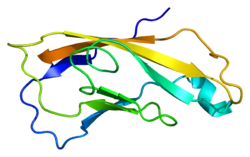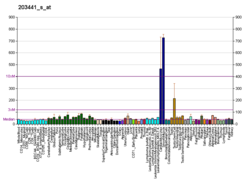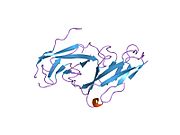Cadherin-2
Cadherin-2also known asNeural cadherin(N-cadherin), is a protein that in humans is encoded by theCDH2gene.[5][6][7]CDH2 has also been designated asCD325(cluster of differentiation325). Cadherin-2 is atransmembraneproteinexpressed in multiple tissues and functions to mediate cell–cell adhesion. Incardiac muscle,Cadherin-2 is an integral component inadherens junctionsresiding atintercalated discs,which function to mechanically and electrically couple adjacentcardiomyocytes.Alterations in expression and integrity of Cadherin-2 has been observed in various forms of disease, including humandilated cardiomyopathy.Variants inCDH2have also been identified to cause a syndromicneurodevelopmental disorder.[8]
Structure
[edit]Cadherin-2 is aproteinwith molecular weight of 99.7 kDa, and 906amino acidsin length.[9]Cadherin-2, a classicalcadherinfrom the cadherin superfamily, is composed of five extracellularcadherin repeats,atransmembrane regionand a highly conservedcytoplasmictail. Cadherin-2, as well as other cadherins,interactwith Cadherin-2 on an adjacent cell in ananti-parallel conformation,thus creating a linear, adhesive "zipper" between cells.[10]
Function
[edit]Cadherin-2, originally named Neural cadherin for its role inneural tissue,plays a role inneuronsand later was found to also play a role incardiac muscleand in cancermetastasis.Cadherin-2 is atransmembrane,homophilicglycoproteinbelonging to thecalcium-dependent cell adhesion molecule family.These proteins haveextracellular domainsthat mediate homophilic interactions between adjacent cells, andC-terminal,cytoplasmictails that mediate binding tocatenins,which in turn interact with theactincytoskeleton.[11][12][13]
Role in development
[edit]Cadherin-2 plays a role in development as a calcium dependent cell–cell adhesionglycoproteinthat functions duringgastrulationand is required for establishment ofleft-right asymmetry.[14]
Cadherin-2 is widely expressed in theembryopost-implantation,showing high levels in themesodermwith sustained expression through adulthood.[15]Cadherin-2 mutation during development has the most significant effect on cell adhesion in the primitive heart; dissociatedmyocytesand abnormal heart tube development occur.[16]Cadherin-2 plays a role in the development of the vertebrate heart at the transition ofepithelial cellstotrabecularand compactmyocardialcell layer formation.[17]An additional study showed thatmyocytesexpressing a dominant negative Cadherin-2 mutant showed significant abnormalities inmyocytedistribution and migration towards theendocardium,resulting in defects in trabecular formation within themyocardium.[18][19]
Role in cardiac muscle
[edit]Incardiac muscle,Cadherin-2 is found atintercalated discstructures which provide end-on cell–cell connections that facilitate mechanical and electrical coupling between adjacentcardiomyocytes.Withinintercalated discsare three types of junctions:adherens junctions,desmosomesandgap junctions;[20]Cadherin-2 is an essential component inadherens junctions,which enables cell–cell adhesion and force transmission across thesarcolemma.[21]Cadherin-2 complexed tocateninshas been described as a master regulator ofintercalated discfunction.[22]Cadherin-2 appears at cell–cell junctions prior togap junctionformation,[23][24]and is critical for normalmyofibrillogenesis.[25]Expression of a mutant form of Cadherin-2 harboring a large deletion in theextracellular domaininhibited the function of endogenous Cadherin-2 in adultventricularcardiomyocytes,and neighboring cardiomyocytes lost cell–cell contact andgap junctionplaques as well.[26]
Mouse models employing transgenesis have highlighted the function of N-cadherin incardiac muscle.Mice with altered expression of N-cadherin and/or E-cadherin showed adilated cardiomyopathyphenotype, likely due to malfunction ofintercalated discs.[27]In agreement with this, mice with ablation of N-cadherin in adult hearts via a cardiac-specific tamoxifen-inducible Cre N-cadherin transgene showed disrupted assembly ofintercalated discs,dilated cardiomyopathy,impaired cardiac function, decreasedsarcomerelength, increasedZ-linethickness, decreases inconnexin 43,and a loss in muscular tension. Mice died within two months of transgene expression, mainly due to spontaneousVentricular tachycardia.[28]Further analysis of N-cadherin knockout mice revealed that thearrhythmiaswere likely due toion channelremodeling and aberrant Kv1.5 channel function. These animals showed a prolongedaction potentialduration, reduced density ofinward rectifier potassium channeland decreased expression ofKv1.5,KCNE2andcortactincombined with disruptedactincytoskeletonat thesarcolemma.[29]
Role in neurons
[edit]In neural cells, at certain central nervous systemsynapses,presynaptic to postsynapticadhesionis mediated at least in part by Cadherin-2.[30]N-cadherins interact with catenins to play an important role in learning and memory (For full article seeCadherin-catenin complex in learning and memory). Loss of N-cadherin is also associated with attention-deficit hyperactivity disorder in humans, and impaired synaptic functioning.[31]
Role in cancer metastasis
[edit]Cadherin-2 is commonly found in cancer cells and provides a mechanism for transendothelial migration. When a cancer cell adheres to the endothelial cells of a blood vessel it up-regulates thesrc kinasepathway, which phosphorylatesbeta-cateninsattached to both Cadherin-2 (this protein) andE-cadherins.This causes the intercellular connection between two adjacent endothelial cells to fail and allows the cancer cell to slip through.[32]
Clinical significance
[edit]Variants inCDH2have been identified to cause a syndromicneurodevelopmental disordercharacterized byCorpus callosum,axon, cardiac, ocular, and genital differences.[8]
One study investigating genetic underpinnings ofobsessive-compulsive disorderandTourette disorderfound that whileCDH2variants are likely not disease-causing as single entities, they may confer risk when examined as part of a panel of related cell–cell adhesion genes.[33]Further studies in larger cohorts will be required to unequivocally determine this.
In humandilated cardiomyopathy,it was shown that Cadherin-2 expression was enhanced and arranged in a disarrayed fashion, suggesting that disorganization of Cadherin-2 protein inheart diseasemay be a component of remodeling.[34]
Interactions
[edit]Cadherin-2 has been shown tointeractwith:
See also
[edit]References
[edit]- ^abcGRCh38: Ensembl release 89: ENSG00000170558–Ensembl,May 2017
- ^abcGRCm38: Ensembl release 89: ENSMUSG00000024304–Ensembl,May 2017
- ^"Human PubMed Reference:".National Center for Biotechnology Information, U.S. National Library of Medicine.
- ^"Mouse PubMed Reference:".National Center for Biotechnology Information, U.S. National Library of Medicine.
- ^"UniProt".uniprot.org.Retrieved26 August2022.
- ^Walsh FS, Barton CH, Putt W, Moore SE, Kelsell D, Spurr N, Goodfellow PN (September 1990). "N-cadherin gene maps to human chromosome 18 and is not linked to the E-cadherin gene".Journal of Neurochemistry.55(3): 805–12.doi:10.1111/j.1471-4159.1990.tb04563.x.PMID2384753.S2CID29840435.
- ^Reid RA, Hemperly JJ (October 1990)."Human N-cadherin: nucleotide and deduced amino acid sequence".Nucleic Acids Research.18(19): 5896.doi:10.1093/nar/18.19.5896.PMC332345.PMID2216790.
- ^abAccogli A, Calabretta S, St-Onge J, Boudrahem-Addour N, Dionne-Laporte A, Joset P, et al. (October 2019)."De Novo Pathogenic Variants in N-cadherin Cause a Syndromic Neurodevelopmental Disorder with Corpus Collosum, Axon, Cardiac, Ocular, and Genital Defects".American Journal of Human Genetics.105(4): 854–868.doi:10.1016/j.ajhg.2019.09.005.PMC6817525.PMID31585109.
- ^"Protein sequence of human CDH2 (Uniprot ID: P19022)".Cardiac Organellar Protein Atlas Knowledgebase (COPaKB).Archived fromthe originalon 24 September 2015.Retrieved20 July2015.
- ^Shapiro L, Fannon AM, Kwong PD, Thompson A, Lehmann MS, Grübel G, et al. (March 1995)."Structural basis of cell-cell adhesion by cadherins".Nature.374(6520): 327–37.Bibcode:1995Natur.374..327S.doi:10.1038/374327a0.PMID7885471.S2CID4314442.
- ^Buxton RS, Magee AI (June 1992). "Structure and interactions of desmosomal and other cadherins".Seminars in Cell Biology.3(3): 157–67.doi:10.1016/s1043-4682(10)80012-1.PMID1623205.
- ^Takeichi M (1990). "Cadherins: a molecular family important in selective cell-cell adhesion".Annual Review of Biochemistry.59:237–52.doi:10.1146/annurev.bi.59.070190.001321.PMID2197976.
- ^Ozawa M, Baribault H, Kemler R (June 1989)."The cytoplasmic domain of the cell adhesion molecule uvomorulin associates with three independent proteins structurally related in different species".The EMBO Journal.8(6): 1711–7.doi:10.1002/j.1460-2075.1989.tb03563.x.PMC401013.PMID2788574.
- ^García-Castro MI, Vielmetter E, Bronner-Fraser M (May 2000). "N-Cadherin, a cell adhesion molecule involved in establishment of embryonic left-right asymmetry".Science.288(5468): 1047–51.Bibcode:2000Sci...288.1047G.doi:10.1126/science.288.5468.1047.PMID10807574.
- ^Angst BD, Khan LU, Severs NJ, Whitely K, Rothery S, Thompson RP, et al. (January 1997). "Dissociated spatial patterning of gap junctions and cell adhesion junctions during postnatal differentiation of ventricular myocardium".Circulation Research.80(1): 88–94.doi:10.1161/01.res.80.1.88.PMID8978327.
- ^Radice GL, Rayburn H, Matsunami H, Knudsen KA, Takeichi M, Hynes RO (January 1997)."Developmental defects in mouse embryos lacking N-cadherin".Developmental Biology.181(1): 64–78.doi:10.1006/dbio.1996.8443.PMID9015265.
- ^Kostetskii I, Moore R, Kemler R, Radice GL (June 2001)."Differential adhesion leads to segregation and exclusion of N-cadherin-deficient cells in chimeric embryos".Developmental Biology.234(1): 72–9.doi:10.1006/dbio.2001.0250.PMID11356020.
- ^Linask KK, Knudsen KA, Gui YH (May 1997)."N-cadherin-catenin interaction: necessary component of cardiac cell compartmentalization during early vertebrate heart development".Developmental Biology.185(2): 148–64.doi:10.1006/dbio.1997.8570.PMID9187080.
- ^Ong LL, Kim N, Mima T, Cohen-Gould L, Mikawa T (January 1998)."Trabecular myocytes of the embryonic heart require N-cadherin for migratory unit identity".Developmental Biology.193(1): 1–9.doi:10.1006/dbio.1997.8775.PMID9466883.
- ^Peters NS, Severs NJ, Rothery SM, Lincoln C, Yacoub MH, Green CR (August 1994)."Spatiotemporal relation between gap junctions and fascia adherens junctions during postnatal development of human ventricular myocardium".Circulation.90(2): 713–25.doi:10.1161/01.cir.90.2.713.PMID8044940.
- ^Forbes MS, Sperelakis N (1985). "Intercalated discs of mammalian heart: a review of structure and function".Tissue & Cell.17(5): 605–48.doi:10.1016/0040-8166(85)90001-1.PMID3904080.
- ^Vite A, Radice GL (June 2014)."N-cadherin/catenin complex as a master regulator of intercalated disc function".Cell Communication & Adhesion.21(3): 169–79.doi:10.3109/15419061.2014.908853.PMC6054126.PMID24766605.
- ^Zuppinger C, Schaub MC, Eppenberger HM (April 2000). "Dynamics of early contact formation in cultured adult rat cardiomyocytes studied by N-cadherin fused to green fluorescent protein".Journal of Molecular and Cellular Cardiology.32(4): 539–55.doi:10.1006/jmcc.1999.1086.PMID10756112.
- ^Dou JP, Jiao B, Sheng JJ, Yu ZB (October 2014). "[Dynamic assembly of intercalated disc during postnatal development in the rat myocardium]".Sheng Li Xue Bao.66(5): 569–74.PMID25332002.
- ^Goncharova EJ, Kam Z, Geiger B (January 1992). "The involvement of adherens junction components in myofibrillogenesis in cultured cardiac myocytes".Development.114(1): 173–83.doi:10.1242/dev.114.1.173.PMID1576958.
- ^Hertig CM, Eppenberger-Eberhardt M, Koch S, Eppenberger HM (January 1996). "N-cadherin in adult rat cardiomyocytes in culture. I. Functional role of N-cadherin and impairment of cell-cell contact by a truncated N-cadherin mutant".Journal of Cell Science.109 ( Pt 1) (1): 1–10.doi:10.1242/jcs.109.1.1.PMID8834785.
- ^Ferreira-Cornwell MC, Luo Y, Narula N, Lenox JM, Lieberman M, Radice GL (April 2002). "Remodeling the intercalated disc leads to cardiomyopathy in mice misexpressing cadherins in the heart".Journal of Cell Science.115(Pt 8): 1623–34.doi:10.1242/jcs.115.8.1623.PMID11950881.
- ^Kostetskii I, Li J, Xiong Y, Zhou R, Ferrari VA, Patel VV, et al. (February 2005)."Induced deletion of the N-cadherin gene in the heart leads to dissolution of the intercalated disc structure".Circulation Research.96(3): 346–54.doi:10.1161/01.RES.0000156274.72390.2c.PMID15662031.
- ^Cheng L, Yung A, Covarrubias M, Radice GL (June 2011)."Cortactin is required for N-cadherin regulation of Kv1.5 channel function".The Journal of Biological Chemistry.286(23): 20478–89.doi:10.1074/jbc.m111.218560.PMC3121477.PMID21507952.
- ^"Entrez Gene: CDH2 cadherin 2, type 1, N-cadherin (neuronal)".
- ^Halperin D, Stavsky A, Kadir R, Drabkin M, Wormser O, Yogev Y (October 2021)."CDH2 mutation affecting N-cadherin function causes attention-deficit hyperactivity disorder in humans and mice".Nature Communications.6187(12): 625–30.Bibcode:2021NatCo..12.6187H.doi:10.1038/s41467-021-26426-1.PMC8548587.PMID34702855.
- ^Ramis-Conde I, Chaplain MA, Anderson AR, Drasdo D (March 2009). "Multi-scale modelling of cancer cell intravasation: the role of cadherins in metastasis".Physical Biology.6(1): 016008.Bibcode:2009PhBio...6a6008R.doi:10.1088/1478-3975/6/1/016008.PMID19321920.S2CID206096620.
- ^Moya PR, Dodman NH, Timpano KR, Rubenstein LM, Rana Z, Fried RL, et al. (August 2013)."Rare missense neuronal cadherin gene (CDH2) variants in specific obsessive-compulsive disorder and Tourette disorder phenotypes".European Journal of Human Genetics.21(8): 850–4.doi:10.1038/ejhg.2012.245.PMC3722668.PMID23321619.
- ^Tsipis A, Athanassiadou AM, Athanassiadou P, Kavantzas N, Agrogiannis G, Patsouris E (September 2010). "Apoptosis-related factors p53, bcl-2 and the defects of force transmission in dilated cardiomyopathy".Pathology, Research and Practice.206(9): 625–30.doi:10.1016/j.prp.2010.05.007.PMID20591580.
- ^abcdeStraub BK, Boda J, Kuhn C, Schnoelzer M, Korf U, Kempf T, et al. (December 2003)."A novel cell-cell junction system: the cortex adhaerens mosaic of lens fiber cells".Journal of Cell Science.116(Pt 24): 4985–95.doi:10.1242/jcs.00815.PMID14625392.
- ^abcWahl JK, Kim YJ, Cullen JM, Johnson KR, Wheelock MJ (May 2003)."N-cadherin-catenin complexes form prior to cleavage of the proregion and transport to the plasma membrane".The Journal of Biological Chemistry.278(19): 17269–76.doi:10.1074/jbc.M211452200.PMID12604612.
- ^Izawa I, Nishizawa M, Ohtakara K, Inagaki M (February 2002)."Densin-180 interacts with delta-catenin/neural plakophilin-related armadillo repeat protein at synapses".The Journal of Biological Chemistry.277(7): 5345–50.doi:10.1074/jbc.M110052200.PMID11729199.
- ^Brady-Kalnay SM, Rimm DL, Tonks NK (August 1995)."Receptor protein tyrosine phosphatase PTPmu associates with cadherins and catenins in vivo".The Journal of Cell Biology.130(4): 977–86.doi:10.1083/jcb.130.4.977.PMC2199947.PMID7642713.
- ^Brady-Kalnay SM, Mourton T, Nixon JP, Pietz GE, Kinch M, Chen H, et al. (April 1998)."Dynamic interaction of PTPmu with multiple cadherins in vivo".The Journal of Cell Biology.141(1): 287–96.doi:10.1083/jcb.141.1.287.PMC2132733.PMID9531566.
- ^Besco JA, Hooft van Huijsduijnen R, Frostholm A, Rotter A (October 2006). "Intracellular substrates of brain-enriched receptor protein tyrosine phosphatase rho (RPTPrho/PTPRT)".Brain Research.1116(1): 50–7.doi:10.1016/j.brainres.2006.07.122.PMID16973135.S2CID23343123.
- ^Sacco PA, McGranahan TM, Wheelock MJ, Johnson KR (August 1995)."Identification of plakoglobin domains required for association with N-cadherin and Alpha -catenin".The Journal of Biological Chemistry.270(34): 20201–6.doi:10.1074/jbc.270.34.20201.PMID7650039.
- ^Sinn HW, Balsamo J, Lilien J, Lin JJ (September 2002)."Localization of the novel Xin protein to the adherens junction complex in cardiac and skeletal muscle during development".Developmental Dynamics.225(1): 1–13.doi:10.1002/dvdy.10131.PMID12203715.S2CID23393425.
- ^Schroen B, Leenders JJ, van Erk A, Bertrand AT, van Loon M, van Leeuwen RE, et al. (May 2007)."Lysosomal integral membrane protein 2 is a novel component of the cardiac intercalated disc and vital for load-induced cardiac myocyte hypertrophy".The Journal of Experimental Medicine.204(5): 1227–35.doi:10.1084/jem.20070145.PMC2118572.PMID17485520.
Further reading
[edit]- Doherty P, Smith P, Walsh FS (1997). "Shared cell adhesion molecule (CAM) homology domains point to CAMs signalling via FGF receptors".Perspectives on Developmental Neurobiology.4(2–3): 157–68.PMID9168198.
- Makrigiannakis A, Coukos G, Blaschuk O, Coutifaris C (2000). "Follicular atresia and luteolysis. Evidence of a role for N-cadherin".Annals of the New York Academy of Sciences.900(1): 46–55.Bibcode:2000NYASA.900...46M.doi:10.1111/j.1749-6632.2000.tb06215.x.PMID10818391.S2CID30583247.
- Hazan RB, Qiao R, Keren R, Badano I, Suyama K (April 2004). "Cadherin switch in tumor progression".Annals of the New York Academy of Sciences.1014(1): 155–63.Bibcode:2004NYASA1014..155H.doi:10.1196/annals.1294.016.PMID15153430.S2CID37486403.
- Cavallaro U (December 2004). "N-cadherin as an invasion promoter: a novel target for antitumor therapy?".Current Opinion in Investigational Drugs.5(12): 1274–8.PMID15648948.
- Salomon D, Ayalon O, Patel-King R, Hynes RO, Geiger B (May 1992). "Extrajunctional distribution of N-cadherin in cultured human endothelial cells".Journal of Cell Science.102 ( Pt 1) (1): 7–17.doi:10.1242/jcs.102.1.7.PMID1500442.
- Knudsen KA, Wheelock MJ (August 1992)."Plakoglobin, or an 83-kD homologue distinct from beta-catenin, interacts with E-cadherin and N-cadherin".The Journal of Cell Biology.118(3): 671–9.doi:10.1083/jcb.118.3.671.PMC2289540.PMID1639850.
- Reid RA, Hemperly JJ (October 1990)."Human N-cadherin: nucleotide and deduced amino acid sequence".Nucleic Acids Research.18(19): 5896.doi:10.1093/nar/18.19.5896.PMC332345.PMID2216790.
- Walsh FS, Barton CH, Putt W, Moore SE, Kelsell D, Spurr N, Goodfellow PN (September 1990). "N-cadherin gene maps to human chromosome 18 and is not linked to the E-cadherin gene".Journal of Neurochemistry.55(3): 805–12.doi:10.1111/j.1471-4159.1990.tb04563.x.PMID2384753.S2CID29840435.
- Selig S, Bruno S, Scharf JM, Wang CH, Vitale E, Gilliam TC, Kunkel LM (April 1995)."Expressed cadherin pseudogenes are localized to the critical region of the spinal muscular atrophy gene".Proceedings of the National Academy of Sciences of the United States of America.92(9): 3702–6.Bibcode:1995PNAS...92.3702S.doi:10.1073/pnas.92.9.3702.PMC42029.PMID7731968.
- Wallis J, Fox MF, Walsh FS (July 1994). "Structure of the human N-cadherin gene: YAC analysis and fine chromosomal mapping to 18q11.2".Genomics.22(1): 172–9.doi:10.1006/geno.1994.1358.PMID7959764.
- Andersson AM, Edvardsen K, Skakkebaek NE (August 1994)."Expression and localization of N- and E-cadherin in the human testis and epididymis".International Journal of Andrology.17(4): 174–80.doi:10.1111/j.1365-2605.1994.tb01239.x.PMID7995652.
- Matsuyoshi N, Imamura S (June 1997). "Multiple cadherins are expressed in human fibroblasts".Biochemical and Biophysical Research Communications.235(2): 355–8.doi:10.1006/bbrc.1997.6707.PMID9199196.
- Navarro P, Ruco L, Dejana E (March 1998)."Differential localization of VE- and N-cadherins in human endothelial cells: VE-cadherin competes with N-cadherin for junctional localization".The Journal of Cell Biology.140(6): 1475–84.doi:10.1083/jcb.140.6.1475.PMC2132661.PMID9508779.
- Gaidar YA, Lepekhin EA, Sheichetova GA, Witt M (February 1998). "Distribution of N-cadherin and NCAM in neurons and endocrine cells of the human embryonic and fetal gastroenteropancreatic system".Acta Histochemica.100(1): 83–97.doi:10.1016/s0065-1281(98)80008-1.PMID9542583.
- Kremmidiotis G, Baker E, Crawford J, Eyre HJ, Nahmias J, Callen DF (May 1998). "Localization of human cadherin genes to chromosome regions exhibiting cancer-related loss of heterozygosity".Genomics.49(3): 467–71.doi:10.1006/geno.1998.5281.PMID9615235.
- Lu Q, Paredes M, Medina M, Zhou J, Cavallo R,Peifer M,et al. (February 1999)."delta-catenin, an adhesive junction-associated protein which promotes cell scattering".The Journal of Cell Biology.144(3): 519–32.doi:10.1083/jcb.144.3.519.PMC2132907.PMID9971746.
- Shan WS, Tanaka H, Phillips GR, Arndt K, Yoshida M, Colman DR, Shapiro L (February 2000)."Functional cis-heterodimers of N- and R-cadherins".The Journal of Cell Biology.148(3): 579–90.doi:10.1083/jcb.148.3.579.PMC2174798.PMID10662782.
- Husi H, Ward MA, Choudhary JS, Blackstock WP, Grant SG (July 2000). "Proteomic analysis of NMDA receptor-adhesion protein signaling complexes".Nature Neuroscience.3(7): 661–9.doi:10.1038/76615.hdl:1842/742.PMID10862698.S2CID14392630.
External links
[edit]- CDH2+protein,+humanat the U.S. National Library of MedicineMedical Subject Headings(MeSH)
- CDH2human gene location in theUCSC Genome Browser.
- CDH2human gene details in theUCSC Genome Browser.
This article incorporates text from theUnited States National Library of Medicine,which is in thepublic domain.











